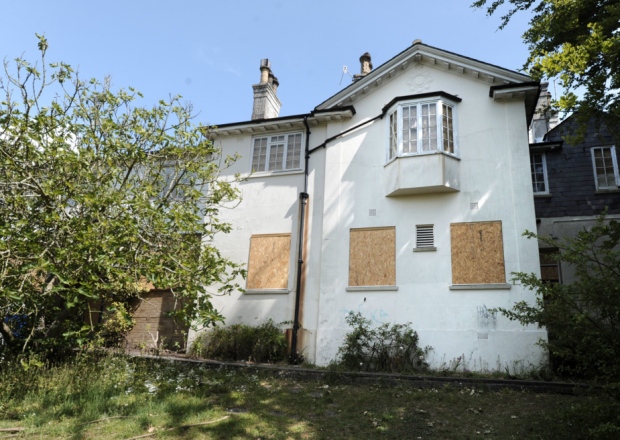
29 Apr St Anne’s: Different Expectations?
A few disgruntled people but some happy ones too!
By Conrad Aldridge, SES Chair for Subud Britain.
[s2If !is_user_logged_in()]
These articles are provided for SESI registered users. You will need to register and log in to view them.
[/s2If]
[s2If is_user_logged_in()]Subud Britain recently decided not to provide its support to the St Anne’s project in Lewes, UK. The reasons for their decision related largely to financial risks associated with the project. What happened and what lessons can we take away from this?
 What was the St Annes project all about?
What was the St Annes project all about?
The Subud Group in Lewes has been expanding (it has in excess of 150 members listed but not that many active ones) and wants bigger latihan spaces.
Subud Britain owns a Subud House in Lewes valued at about £900,000 (USD $1.3 million)
The local County Council had an old and disused house, that had once been used as a school, in about 4 acres of land that they wanted to be reserved (as a Park) for community use. The property was called St Annes (A patron Saint, one of whose responsibilities is to guard against storms!)
The Council decided to dispose of the property (at a price lower than a normal property price to reflect the on-going obligations that would be placed upon the purchaser to serve the community) and invited bids from organisations with community interests who would be expected to develop and maintain the site in the best interests of the community.
 Some members in the Lewes Subud Group (the Team, whose composition changed several times over the life of the project) saw this as an opportunity to buy the site and build a new latihan hall for Subud and make the property available to the general public too. Of course some other members of the Group were against the idea but the Team got the go ahead from the Group’s committee – who had been keeping members’ contributions (actually, Subud Britain’s money!) to spend on getting a new bigger hall for latihan.
Some members in the Lewes Subud Group (the Team, whose composition changed several times over the life of the project) saw this as an opportunity to buy the site and build a new latihan hall for Subud and make the property available to the general public too. Of course some other members of the Group were against the idea but the Team got the go ahead from the Group’s committee – who had been keeping members’ contributions (actually, Subud Britain’s money!) to spend on getting a new bigger hall for latihan.
A costly bid was submitted which proposed Plan A, a phased development of new buildings and assumed demolition of the old house on the site and landscaping of the grounds. The Council liked it and so did the Chairman of Subud Britain at the time!
The local Land Trust who had also put in a bid, objected strongly saying that Subud was not a community organisation. The Land Trust had support from other disgruntled local residents – some of whom were well connected and determined to prove their point by discrediting Subud and, as they projected it, it’s discriminating ethos, amongst other things. Their determination caused a public enquiry which slowed down the whole affair and gave the Team time to re-vamp their proposals after discovering that Plan A was miles too expensive. Plan B, C and D emerged as critiques of each version were used to fill the holes ready for the next iteration of the Business Plan. The process went on for three years or more and the Team were given, and used, every opportunity to present their latest thinking to the Lewes Subud Group, Subud Britain’s National Council and Congresses too including the World Congress in Mexico.
The eventual plan, rejected by Subud Britain, required Subud to sell the existing Lewes Subud House which was an appreciating asset in a good part of Town, accept easy terms loans and gifts from some of the Group and other Subud members and either have a Bank loan or other Group property sale to fund the £500,000 (UDS $725,000) shortfall in the overall required funding. The final plan had no new building but assumed the refurbishment of the existing school. One of the worries for the Subud Trustees was the ability of proposed and speculative enterprise activity to service the anticipated debt.
Another concern was that the Council’s Lease of the property to Subud (the original Sale option had been withdrawn because the Council wanted a stronger hold on Subud) required the land to be maintained and retaining walls to be looked after for the 125years term of the Lease whilst giving the public access. The cost of all this was difficult to quantify.
Subud members and local residents asked if this was a project for the Community? Or, was it intended to be a way of Subud getting some cheap land?
The Team were advised that a project really owned by the Community could have applied to the UK Government and other charitable donors for funding – something that Subud could not do.
Anyway, on Sunday 17 April 2016 the Trustees of Subud Britain (SB) at last took the decision not to support the St Anne's Project in Lewes having sought expert help from well qualified advisers. They issued a statement thanking the Team for all their work and giving half a dozen reasons along the lines described above for their decision.
These were to do with financial risks associated with the project with its unpredictable costs and uncertain obligations arising from the leasing of the property. There were doubts too about the on-going management and staffing.
Some people thought that the County Council were also relieved that the bid had in the end failed to get Subud’s support. No mention was made by the Subud Trustees of the continuing antagonism towards Subud from some non Subud Lewes residents.
There was a sigh of relief from many members and office holders, some people were very happy. The final sentence in Subud Britain’s statement to the members read as follows:-
“Whilst this will be a disappointing outcome to those closely involved, the project overall had demonstrated real strength in our ability to work together and this should not be forgotten. The time and effort put into this project by the St Anne’s team and all concerned is not wasted as much has been learnt that can help us in the future.”
Towards the end of the project, Subud Britain’s Trustees realised that they needed to prepare guidelines for other prospective project creators to bear in mind when looking for Subud’s support. Here are the procedures proposed to SB’s National Council in the last year and accepted unanimously by the Trustees in an attempt to avoid similar situations developing again in the future.
Guidelines for those promoting a new project, where they want Subud Britain’s support.
- The promoters should talk about their project to the local Group’s Committee.
There should be a quorum (one third) of active members at the Group. [A list of active members should be maintained by the Group’s Secretary. If in doubt contact the National Membership Secretary]
Does the committee agree to support the idea? If a majority are in favour, proceed to 2 below. If not, re-think the project and retry/re-present their proposal to the Group Committee.
- Now that the Group Committee agrees to take matters forward:-
The Promoters should prepare an outline of the proposal for the Group Chairman (and proposers) to present to and discuss with the Group before taking the project proposal to the Regional Council. This proposal should include a rough plan of what is expected to happen next – to keep all parties informed. If there is to be expenditure a budget of the anticipated costs must be prepared for prior approval before any money is spent.
- The Group should inform the Region and ask for the Regional Council’s agreement to adopt/support the project.
If the Regional Council does not agree, go back to 1 above.
- A majority of the Regions Group Chairs in favour.
If the Regional Council does support the proposal then a summary document should be prepared for Subud Britain’s Trustees consideration and given to the National Secretary for inclusion in the next NC meeting’s agenda.
Subud Britain’s criteria for offering support to proposers of new property related projects.
Any and all proposed expenditure on the project has to be agreed in advance by Subud Britain’s Trustees. (A majority of the Trustees in favour.) Prior agreement by the Trustees also applies to any agreements with third parties that might involve Subud Britain.
If any of Subud Britain’s money is spent (or Agreements are made with third parties) before agreement of Subud Britain’s Trustees has been obtained the project will automatically be stopped, no further support for that project will be forthcoming.
Any building needs to be fit for purpose offering as a minimum, suitable latihan spaces, (sizes?) meeting rooms, kitchen, toilets and car parking. Expandable if possible. There has to be one or more profitable supporting enterprises – our minimum currently seems to be a cash generating business offering rooms for hire.
Best if there is a minimum or (the preference) no reliance on the unpaid involvement of Subud members for maintaining the building or grounds or for voluntary working in the supporting enterprises.
The place/proposal has to be affordable – has SB got the money or can it borrow without excessive risk?
There needs to be a clear “exit route” for Subud Britain, probably by means of a re-sale of the property, to minimise the risk of having to keep an unwanted property.
Ideally there would be overnight accommodation for visitors. Environmentally friendly, compliant with all Regulations without relying on the goodwill of members! Minimal Risk.
Can we draw any useful conclusions?
So, what conclusions can we draw, if any, from the St. Anne’s experience. In a way, this is a classic circumstance that could occur in other countries and/or with Subud organisations at local, national or even international levels anywhere especially when the Subud Committees are keen to see things happening and really want to support any initiatives.
It is common knowledge that there has been a mild falling out between the SA project and Subud Britain about the process and the outcome. Some of the Team remain disgruntled, but there is no point making matters worse by taking sides on that and the only real observation to be made is Bapak’s often reiterated advice that we must work in close cooperation with each other as harmony is an essential prerequisite of success in Subud.
It seems to me that at times both the SA project and SB had different expectations and it is important for future endeavours that all expectations are made as explicit as possible and clarified as early as possible in order to avoid misunderstandings. The St Anne’s project has done us all a favour and SB has moved to clarify some of the terms on which it will provide support.
More broadly, it also appears that financial or commercial risks and the Subud organisation don’t mix well. This doesn’t mean that the organisation can’t or won’t lend money or make guarantees to acquire property. But the probability is that the risk profile will need to be very low. And, that the project will need to be substantially for latihan use rather than be mixed with other elements that, whether social or commercial, create additional risk. Those people entrusted with the financial well-being of the organisation, be they trustees, directors, committee members or other office bearers, will always naturally feel they need to err on the side of caution, especially when they might become personally liable if decisions are considered to be irresponsible.
Perhaps we can say there should be a separation between commercial and not-for-profit activities. Or at least be completely clear about which is paramount in any particular project. If the Subud component (latihan hall) could have been separated from other aspects of the SA project, a different request to SB and a different outcome might have occurred.
Does the SA experience mean that the organisation will not or should not have any part in enterprise? Well, clearly it is members and groups of members in companies that should be doing enterprises who should embark on enterprises, not the Subud organisation.
The organisation can facilitate, foster and perhaps even help initiate, but it is not its role to run enterprises. There MAY be limited times when the organisation might directly support an enterprise activity in return for equity or some other form of return on investment , for example by investing, buy making a small loan or by providing a guarantee. But realistically this is only going to occur in very few circumstances and only where the amount or quantum of money at risk is small, finite and well within the means of that part of the organisation to lose, if it must.
In short, and without any reflection on the St Anne’s project which had wonderful ideas, what we can say is that enterprises should stack up as enterprises. Ideally, we’ll soon get to a point where enterprises are supporting the organisation financially rather than looking for financial support. And where there is a community of entrepreneurs and enterprises, possibly via SES, who support each other.
And lest anyone think this article is intended to be critical of those people in the SA project who genuinely made an effort to do something enterprising, something of value, I’ll just close this article with the following quote from Bapak.
This is the fruit that we can look forward to – the guidance that comes from the jiwa which is always close to the power of God. The result of that, or the direction in which it takes us, is a society which is harmonious, united and prosperous, where people are close to each other and where they take responsibility together for everything that happens. That is, in general. In particular, it will mean that in this Brotherhood of ours, in Subud, we will truly care for each other, we will truly feel for each other, we will truly know the state of each other. For example, if it happens that one of our enterprises fails, everyone will share that failure, will help and try to support the people who have lost out. Not like now when your enterprise fails and everybody turns the other way. Nobody cares. [77 SFO 2]
[/s2If]




Sorry, the comment form is closed at this time.